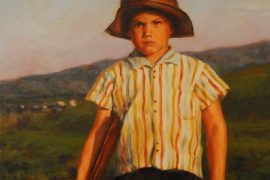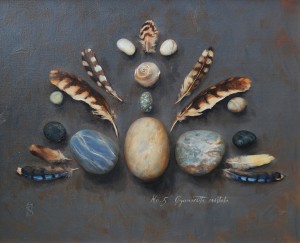Sam doesn’t remember this, but when she and I were in middle school, I used to ride home with her on the bus after school, when we’d watch Godzilla on television and eat her mother’s homemade potato bread. At that time, she said she wanted to be a veterinarian (like her dad). Instead she earned a BA in art and then her MFA. Since 2010, she’s discovered her talent in oil painting.
Samantha Hand has some mad skills when it comes to oils and canvas. And even I was surprised by the math that she uses. Unlike most of the other folks I’ve interviewed for Math at Work Monday features, Sam really counts on being able to visualize the math she needs. Read on…
Can you explain what you do for a living? For the last two years, I have completely immersed myself in oil painting and have tackled landscape, plein air, still life and portraiture. Currently I am painting compositions that intrigue me in hopes of selling them, while accepting commissions on a variety of subjects. Recent projects include still life and figurative painting.
When do you use basic math in your job? I use the most math at the beginning stages of a painting. When I am sketching thumbnail ideas, I use the rule of thirds to compose a more interesting picture. I use a variety of angles to draw the eye toward the focus of the picture and to lead the eye around the composition. I also use angles in drawing perspective when I am attempting to create depth in a two-dimensional space. (For example, the angle of a building is wider in the foreground and will go toward a vanishing point as the building retreats into the distance)
If the composition is complex, as in a triple portraitI am currently working on, I use a grid to enlarge smaller reference images to the larger size of the canvas. This helps to keep the proportions of the sketch on the canvas accurate. Proportions are also important in balancing the values and subject matter in a composition. I check to see if the proportion of dark values is greater or lesser than the proportion of light values to add interest. I may balance the visual weight of the subject with a greater space of sky to create visual tension or to draw the eye toward the subject.
Mr. Allison’s Hat
When I am sketching the figure I am constantly checking my proportions by comparing the size of body parts. For example, in most faces the space between the eyes is the width of one of the eyes in the face. Also, in general, people are approximately 6 and a half heads tall. I use a paint brush or pencil to measure and compare. I also use this measuring and comparing in all other subject compositions to check my spacing and proportions.
Once I begin painting, I use ratios in the mixing of colors. If I am looking for a purple I may mix an equal amount of red and blue. But if I want a warmer purple with a reddish tint I’ll use less blue in the mixture. Throwing in the amount of yellow equal to the red will turn it toward a brown. Equal measures of red, blue, yellow becomes a neutral gray. There are infinite numbers of colors to be mixed which is one of the most exciting things about painting.
Do you use any technology to help with this math? I do not use a calculator or computer because the math I use is simple and not very exact. It is more about the feeling of balance or rightness. If something doesn’t feel right with the composition I begin to check using more exact measurements and angles.
How do you think math helps you do your job better? Math is the building block of my compositions. I use angles and proportions to try and create intriguing compositions with believable subject matter.
How comfortable with math do you feel? I am very comfortable with the math I use in my artwork but less so with the everyday math of a household. Somehow I feel as if I can visual the math I use in compositions and it makes sense to me. When I apply it to household tasks I have to really focus on the task at hand.
What kind of math did you take in high school? I only vaguely remember my classes in high school but did take math analysis, geometry and the other algebra courses offered. I really enjoyed my math classes and felt confident in my ability, though less so with geometry. I continued with a calculus course in the first year of college and enjoyed that also. Unfortunately, I think I’ve only retained very simple math skills.
Did you have to learn new skills in order to do the math you use in your job? I haven’t had to learn any new skills yet but I have learned to use the math I know in tangible situations.
Did you have any idea about the math that goes into planning a painting? If you have a question for Samantha, ask it in the comments section.
This month, Math for Grownups has gone arty, taking a close look at how math shows up in the visual arts. Last week, glass blowing took center stage.


